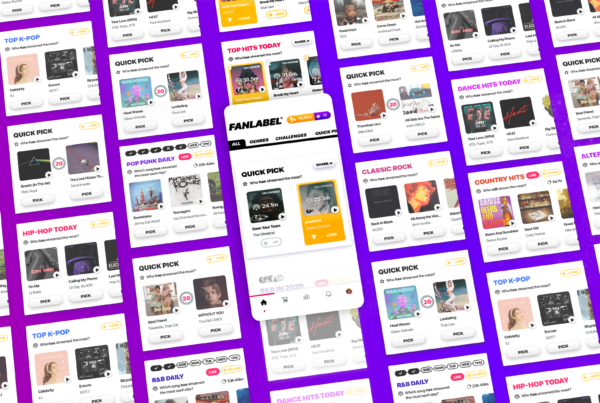At FanLabel, we’re fascinated by the ins-and-outs of the music industry. Among the many aspects that get us all riled up is the art itself: the songs. Long before they’re sung, recorded and streamed, they’re written. We’re particularly interested in the anatomy of a song, and how to create a great one. So we’re diving into the fundamentals: the elements that make up a song, basic songwriting techniques, song structure rules, what makes a song commercially successful and more.
To help us learn the ropes of songwriting, we sat down with Kelly Bolton, vice president of creative at Tape Room Music, a Nashville-based publishing company.
Let’s go to school.
Tips for song construction
First, let’s ask ourselves, what do songwriters need to consider when constructing a song?
According to Bolton, there’s a secret sauce, and it all starts with the song’s form, or how you structure the verses and choruses in a sequence that makes sense.
So, what exactly the best way to form a song?
“You don’t want to have a bunch of random verses with no real defining anchor of a chorus if you’re looking to be commercially successful,” Bolton said. “Form is very important. When is the verse, when is the next chorus, when is the third verse, is there a bridge? Those are things to consider when writing a song.”
Of course there are many different ways to write a song, and it may vary by genre, but there are common practices when it comes to the form of a song.
What is the most common type of song structure, at least from a commercial standpoint?
“The most common format I see (in commercial music) is verse-chorus-verse-chorus-bridge-chorus,” Bolton said. “The other common form is two verses before the first chorus, so it would go verse-verse-chorus-verse-chorus.”
The other frequently used format you may hear is when several verses come before the chorus hits, while the bridge is what feels different throughout the whole song. This particular format is used more in rock, alternative/indie or even bluegrass, as opposed to something we’re used to hearing in the pop or country realms.
A bridge is generally two lines that happen in between the middle chorus and the last chorus. A lot of times lyrical bridges may be absent from a song, and replaced with a guitar solo or instrumental instead.
“Don’t bore us, get to the chorus”
No matter what form is used to construct a song, a strong chorus is key to catch listeners’ attention. A typical chorus is anywhere from four to eight lines long, and it needs to come about quickly, or you risk losing the attention of the listener.
“Nowadays, people really want the chorus pretty soon,” Bolton said. “I went into a writers’ room one day and somebody had written on a chalkboard: ‘Don’t bore us, get to the chorus.’ And that’s totally true. There’s this kind of running idea of getting into the chorus before a certain amount of time passes so that it’s good for commercial use.”
The reason we need to get to the chorus quickly is because human attention spans are selective. However, looking at this from a commercial standpoint, not only do we want the chorus to hit quickly, we want to keep songs in their entirety short and sweet. According to Bolton, a rule of thumb songwriters may want to follow is keeping songs around three-minutes-and-thirty-seconds or less.
Another key component to just about any song is the “hook.” The hook has to “punch” and draw listeners in, which is why it is fittingly named. The chorus contains the hook. Generally its placement is within the last two lines of the chorus, and we typically wait for the hook toward the end of said chorus (at least in country music).
A good example of a strong hook, according to Bolton, is Cole Swindell’s “Break Up in the End”:
The hook: “I’d do it over and over, again and again, even though we break up in the end.”
“Constructing a song is kind of like writing a good paper,” Bolton said. “I look at the hook as the thesis, where every single line is pointing to the main idea of the song. If it doesn’t all add up to the chorus in a clear way, it’s probably not going to come off as a very strong from a lyrical standpoint.”
Melody must connect with listeners
Melody should be something that hits you in the feels while you’re listening to it. It could be a recognizable sound, a good vibe or something that makes you want to hum or sing along with it:
“Melody should feel good to listen to,” Bolton said. “Is the chord progression something that’s familiar? Does it feel like something we can sing back? A lot of times when a melody is too complex, it’s hard for an audience to learn it, and it doesn’t feel like a commercial hit because it’s difficult to sing back.”
Imagery is also important when it comes to lyrics, which allows listeners to connect with the artist and liken their experiences to your own life.
“Roller Coaster” by Luke Bryan is a good example of this because as a listener, you’re able to visualize the lyrics and can place yourself right at the scene.
Bolton warns not to get too descriptive with lyrics, but to use elements that are defining and impactful.
She leaves readers and aspiring songwriters with this last piece of advice:
“The general rule of commercial songwriting is just finding, both musically and lyrically, how to relate to the masses. Knowing your demographic and just sticking to that and really understanding that (is essential). If you’re writing commercially, it’s important to know that you’re trying to write for a lot of people. Try not to get too niche in terms of topic or sound. If you’re an aspiring songwriter, the best chance you have to get a song cut is by aiming wide.”
Our last piece of advice–definitely not as advised by Bolton–head for the shower, and start working on your own hit song!





